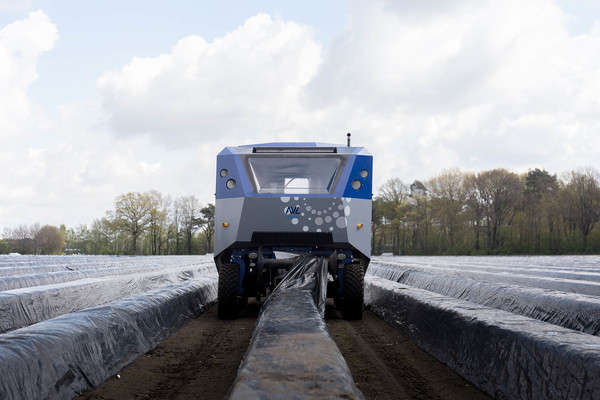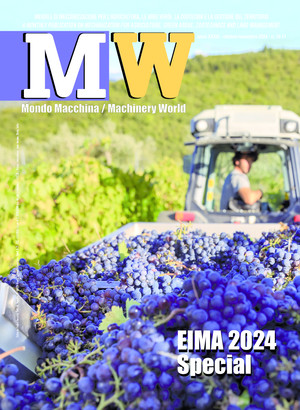
Asparagus harvesting: an evolving mechanization
Like several other crops in Italy, asparagus has historically experienced little mechanization because of the plant's specific characteristics. However, some dedicated harvesters are now available
Commonly known as asparagus, Asparagus Officinalis L. is a perennial plant native to the eastern area of the Mediterranean basin. The plant consists of a rhizome from which shoots (the turions) sprout annually during the growing season. Thanks to geotropism, these sprouts develop vertically until they emerge from the ground in late winter or early spring as the temperature rises. When they begin to emerge, turions are white, but then, through photosynthesis, they change color, first from pink to purple and finally to green.
Farming forms
Asparagus establishment is multi-annual, therefore, it cannot be included in crop rotations. In asparagus farms, after the first two years dedicated to growth, the plant has a production peak in the third and fourth year, after which productivity stabilizes between the fifth and twelfth years and then decreases until the crop is extirpated.
A very important stage in asparagus cultivation is seedbed preparation: after very deep autumn plowing (50-60 cm), also aimed at complete fertilization, the surface is harrowed and then leveled. Beds (convexities of the soil) are then established, on which seeds are laid or legs placed for agamic propagation. Usually, the planting size adopted is 1.5-1.6 m between rows and 33-40 cm on the row. The shoots are harvested in spring, about 60 days after the shoots emerge from the stem. Since it is a continuous production, harvesting is done in steps to maximize the crop's yield, picking the shoots about 10-12 cm above the ground.
Hand-harvesting
Hand-harvesting is still the most common solution, and it, unfortunately, forces the workers to be constantly stooped over the ground, despite the presence of beds. In this case, the only facilitating implement is the gouge, a long knife curved at the end used to cut off the shoots 10-15 cm below the soil surface. In order to harvest, since the asparagus is buried at least half of its length, operators must bend over, leading the gouge along the asparagus, and through the management of the implement, sever the shoot and extract it from the ground so that it can be deposited inside the special boxes for storage and processing. The only apparently simple procedure forces operators to exert considerable muscle effort that can result in physical discomfort in the long run.
Facilitator machinery
Almost all models allow workers to work seated to minimize loads on the trunk and back. These are small, single-seat machines with 3 or 4 pneumatic wheels and a small diesel or electric motor propulsion system. The electric solution is preferred in sheltered settings to avoid the accumulation of harmful gases in the confined environment. Also related to electric propulsion, for harvesting in the open field, there is the possibility, in some cases, of installing solar panels on the roof to recharge the onboard battery. The driver's seat is in a central position, and the operator is seated with his legs outstretched, resting on two special supports. He lays the harvested product in crates placed on two shelves located on the side of the seat.
The varietal difference between green and white asparagus conditions the configuration of these machines because the green ones stick out of the soil while the white ones do not. Rather, the latter are grown under white mulch sheets to prevent them from greening up should they sprout from the ground.
Therefore, models for harvesting white asparagus are equipped with rollers for lifting and then placing the mulch sheets back on the ground.
Harvesting machinery
Despite the ergonomic improvement facilitator machinery provides, asparagus harvesting is still time-consuming and labor-intensive. Some manufacturers produce machines for mechanized harvesting of asparagus from the ground (such as France's Kirpy), with substantial reductions in time and labor. The machine consists of a single-axle frame and is towed by the tractor set up with trackways suitable for passing between beds.
The harvester head is equipped with two pairs of discs that trim the soil of the edges of the bed and a cutting organ, which in turn consists of two partially overlapping rotating discs that rotate on a plane inclined with respect to the direction of travel, that cuts and undermines the shoots 10-15 cm below the top of the bed.
The severed asparagus are then conveyed onto a grated conveyor belt to remove the intercepted soil residue along with the product.
Below the first conveyor belt is a second made of plastic material, from which operators on board pick up the shoots and place them in the boxes. Any remaining soil is discharged to the rear of the machine onto the bed. This is a huge increase in harvesting productivity, however, as is often the case at these junctures, scalar harvesting is not possible, as is the case with the manual solution, which ensures greater uniformity of product caliber.
Automatic harvesting machinery
A higher level of mechanization is highly automated machinery capable of harvesting shoots with as few operators on board as possible, such as Compact S9000 for white asparagus harvesting, produced by AVL Motion. The machine is actually a robot operated by a single operator on the ground, which checks its operation and directs it to the harvesting row using radio control. However, the vehicle has a small rear platform, allowing the operator to check the product being conveyed into the boxes.
It is basically a tool carrier chassis driven by a 4-cylinder Stage 5 diesel engine, on which the harvesting unit is housed. The overall dimensions are large, namely 6 m in length, 2.3 m in width, and 2.9 m in height, for a mass of about 4500 kg. The maximum working speed is about 3.6 km/h for a harvesting capacity of 9000 shoots/hour.
The harvesting module includes a system for moving and shifting the mulch sheets as the machine passes. It consists of two rollers, one at the front that lifts and shifts the asparagus cover laterally and one at the back that places the cover back in its original position.
The detection of the shoots and subsequent harvesting is done using a number of optical sensors which guide the cutting organs along the body of the asparagus to a defined depth and then release the product onto a conveyor belt for conveyance into the boxes. With this solution, the asparagus are picked individually, therefore, soil contamination of the products is still limited.
The most popular varieties
Asparagus is a well-known crop throughout Europe: in the Mediterranean basin, the most popular variety is green, while in northern Europe and the Veneto region, white cultivars are preferred.
Nationally, they range from green to white asparagus, purple asparagus and wild asparagus or "asparagine ."Their varietal characteristics and different vocations in the area of origin have led some of them to IGT brand recognition.








